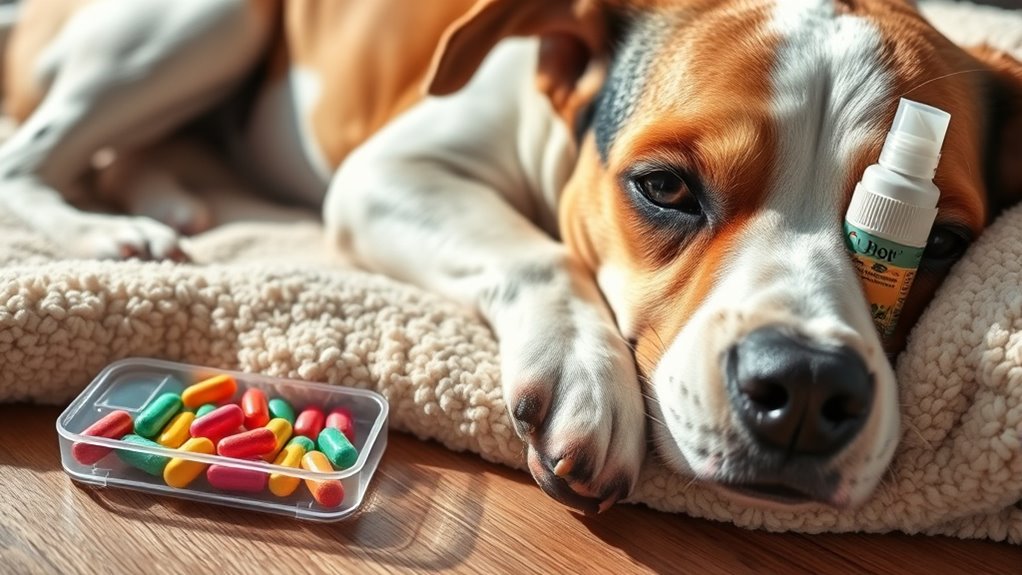To effectively prevent fleas, ticks, and worms, you should stick to a consistent routine that includes regular grooming and pest checks, preferably weekly. Consult your vet to choose the best preventive treatments like topical, oral, or collars, and follow the recommended schedule. Also, keep your environment clean by washing bedding and vacuuming frequently. Combining these strategies with outdoor maintenance will give your pet the best protection—continue to discover how to optimize your plan.
Key Takeaways
- Schedule regular vet visits to tailor a comprehensive prevention plan with effective medications and vaccinations.
- Implement consistent weekly grooming and pest checks using flea combs and inspection of ears and paws.
- Use veterinarian-recommended monthly topical, oral, or collar treatments for continuous protection.
- Maintain a clean environment by washing bedding, vacuuming, and keeping outdoor areas tidy.
- Combine preventive medications with environmental controls to reduce pest habitats and minimize reinfestation risks.

Are you doing enough to protect your pet from fleas, ticks, and worms? These tiny parasites can cause big health problems if you’re not proactive. The key to a successful prevention plan starts with regular grooming and routine veterinary visits. Dog grooming isn’t just about keeping your pet looking good; it’s an essential part of checking for signs of pests or skin irritations that might indicate an infestation. During grooming sessions, you can inspect your dog’s coat, ears, and paws, looking for fleas, ticks, or any suspicious bumps or redness. Using a flea comb regularly can help catch pests early before they multiply or cause discomfort. Incorporating preventive care into your routine ensures early detection and management of potential issues.
Veterinary visits are equally important. Your vet can recommend the most effective preventive treatments tailored to your dog’s age, breed, and lifestyle. These visits give you an opportunity to discuss the latest flea, tick, and worm preventatives and ensure your pet is up to date on vaccinations and deworming schedules. Preventative medications, such as topical treatments, oral pills, or collars, are proven to be highly effective when used correctly. Your vet can advise you on the best options, how often to administer them, and whether you should combine them with other health measures.
It’s important to establish a consistent routine. Don’t wait until you see signs of pests or worms—prevention is always better than cure. Incorporate regular grooming into your weekly schedule, making it a habit to check your dog thoroughly. When you visit the vet, ask about a detailed parasite prevention plan that fits your pet’s specific needs. This might include monthly topical treatments, oral medications, or even environmental control measures to reduce the risk of re-infestation.
Another essential step is maintaining a clean living environment. Regularly wash your dog’s bedding, vacuum your home, and keep outdoor areas tidy. Parasites thrive in cluttered, dirty areas, so reducing their hiding spots minimizes the chance of infestation. Also, be mindful of outdoor activities, especially in wooded or grassy areas where ticks are common. After walks or playtime outside, give your dog a thorough check, especially around the ears, neck, and between toes.
Frequently Asked Questions
Are Natural Remedies Effective for Flea and Tick Prevention?
You might wonder if herbal alternatives and essential oils can effectively prevent fleas and ticks. While some natural remedies, like peppermint or eucalyptus oils, have repellent properties, they often aren’t as reliable as commercial products. Essential oils may help in reducing pests, but they shouldn’t replace proven prevention plans. Always dilute oils properly and consult your vet before using them, as natural doesn’t always mean completely effective or safe.
How Often Should I Rotate Different Prevention Products?
Imagine your pet’s safety as a delicate dance—each move must be timed perfectly. You should rotate prevention products every 3 to 4 months, keeping pests unsure of your pet’s defenses. Seasonal adjustments are vital; switch products more frequently in peak pest months. Regular product rotation prevents resistance and guarantees continuous protection. Stay vigilant, adapt your plan, and maintain that rhythm to safeguard your furry friend effectively.
Can Prevention Plans Be Safely Used With Other Medications?
You wonder if prevention plans can safely be used with other medications. It’s crucial to take into account potential drug interactions, which can affect your pet’s health. Always consult your veterinarian for guidance before combining prevention products with other drugs. They can review your pet’s medications and ensure safety, preventing adverse effects. Following veterinary advice helps protect your pet and ensures the prevention plan works effectively alongside other treatments.
What Are Signs of Side Effects From Prevention Treatments?
You might notice side effect symptoms like vomiting, diarrhea, lethargy, or skin irritation after starting prevention treatments. If you see these signs, it’s important to act quickly. You should contact your veterinarian for treatment options and guidance. Monitoring your pet closely helps catch any adverse reactions early, ensuring they stay safe and comfortable. Always follow your vet’s advice to minimize risks and address side effects promptly.
Do Prevention Plans Work Equally for All Dog Breeds?
You wonder if prevention plans work equally for all dog breeds. The truth is, breed-specific efficacy and size considerations matter. Some treatments are more effective for certain breeds or sizes, so you should choose products tailored to your dog’s specific needs. Always consult your veterinarian to guarantee you select the right prevention plan, giving your dog the best protection regardless of breed or size.
Conclusion
By sticking to a consistent prevention routine, you protect your pet like a shield guarding treasure. Regular treatments, thorough checks, and veterinarian advice create a strong barrier against fleas, ticks, and worms. Think of it as a dance where you and your pet stay in step, avoiding any unwanted pests. When you stay proactive, you’ll enjoy peaceful, happy moments together—free from the worries of parasites. Keep up your plan, and your pet will thank you for it.










